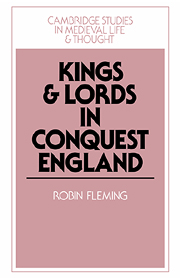Book contents
- Frontmatter
- Contents
- List of figures
- List of tables
- Preface
- List of abbreviations
- PART I CNUT'S CONQUEST
- 1 Landholding and alliance in late Saxon England
- 2 Cnut's conquest and the destruction of the royal kindred
- 3 New men and the waning of the West Saxon monarchy
- PART II THE NORMAN CONQUEST
- Bibliography
- Index
2 - Cnut's conquest and the destruction of the royal kindred
Published online by Cambridge University Press: 09 October 2009
- Frontmatter
- Contents
- List of figures
- List of tables
- Preface
- List of abbreviations
- PART I CNUT'S CONQUEST
- 1 Landholding and alliance in late Saxon England
- 2 Cnut's conquest and the destruction of the royal kindred
- 3 New men and the waning of the West Saxon monarchy
- PART II THE NORMAN CONQUEST
- Bibliography
- Index
Summary
Ecclesiastical writers, commenting on the years following Cnut's coronation, portrayed the king as Edmund's legal heir and the preserver of Edgar's laws and praised him as a devoted protector of the English Church and its faith. Cnut's surviving charters support this contemporary view, demonstrating that English thegns and sheriffs continued, as custom dictated, to aid in the governance of the realm, and establishing that the new king's diplomatic practices were firmly rooted in those of his predecessors. The only administrative innovation that both the Dane's contemporaries and later historians have noted is Cnut's introduction of a new secular official, the earl, paired with the gradual extinction of the office of ealdorman during his reign.
Even this reform, however, is thought to have had only slight effect. The powers with which Cnut's earls were endowed and the regions with which they were entrusted, mirrored those pertaining to the ealdormen of his predecessor's day. What few modifications to the office there were – the increasing emphasis on large regions of responsibility and a greater delegation of authority – are generally attributed to the military demands of Cnut's northern empire rather than the political circumstances in which England found itself after the Viking conquest. The transformation from ealdorman to earl, therefore, is seen as one of title rather than responsibility.
- Type
- Chapter
- Information
- Kings and Lords in Conquest England , pp. 21 - 52Publisher: Cambridge University PressPrint publication year: 1991



